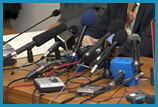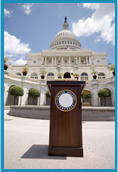
PAGE INDEX
a. Press Conference Planning
b. Press Conference Logistics
c. Advance Outreach
d. Prepare a Press Kit
e. Follow-on Activities
Planning an Effective Press Conference

Press conferences should be held to introduce timely and important news related to crime victims, victims’ rights, victim services, or public safety to your community. This can include—
- Passage of a new victims’ rights statute and its application to victims and assistance programs in the community.
- Major research at the national, state, or local level (always providing a “local angle”).
- A new program or service to assist victims.
- New collaborations or partnerships that streamline and improve victim services and public safety.
While press conferences require considerable planning, the “tools of the trade” included in this section will make your task much easier. Please refer to them to write an effective press release or editors’ advisory; develop public service announcements; and provide spokespersons for radio and television talk shows.
It’s important to establish a clear goal for a press conference—exactly what you seek to achieve. Once a goal has been determined—
- Consider the people who will present the information. It helps to have a notable guest (such as an elected official), expert(s) on the subjects being addressed, and a crime victim who can offer the “human side” to the information. Diversity in presenters by gender, culture, and area of expertise is essential.

- Develop a plan that includes the order of speakers, how they will be introduced, and how long they will speak. It helps to prepare unobtrusive “time cards” within view of speakers that tell them when they have “2 minutes,” “1 minute,” and “no time left” to keep to a schedule.
- Visuals add an extra spark to press conferences and are helpful for photographers and videographers. A large banner and podium sign with information about the sponsoring organization(s) and/or topic(s) visually depict the purpose of the press conference. Creative visuals that depict the key messages of the press event—such as the Clothesline Project featuring tee shirts honoring domestic violence victims, or pairs of shoes that show the number of people murdered or number of children abused in a community—offer excellent opportunities for both print photographs and broadcast coverage of press conferences.

- Plans should also be made to bring key speakers together for a photo opportunity. Some press conference sponsors like to document the event with their own videographers and photographers.
- Most press conferences are 20 to 30 minutes, including a question-and-answer period. This requires careful planning and speakers who can adhere to a tight schedule.
- A question-and-answer period should include determination of a facilitator and length of the Q-and-A session. The facilitator should be prepared to answer any questions as well. All speakers should be advised that if they do not know the answer to a question, they should say so and offer to provide follow-on information to the requestor.
- The location of a press conference is often critical to its success. It helps to plan for a venue that can accommodate a crowd and is accessible by public transportation. If a permit is required, obtain one and have a copy readily available on the day of the event. If the press conference is outdoors, have a contingency plan for inclement weather. Compliance with the Americans with Disabilities Act is also important.

- It’s best to hold a press conference on Tuesday, Wednesday, or Thursday between 11 a.m. and 2 p.m. This increases the opportunities for a “live at noon” news broadcast, making the evening news, and providing plenty of time for daily newspapers to write the story.
- It’s also helpful to, in advance, check “community calendars” on the Web sites of newspapers and broadcast stations in order to avoid competing with other newsworthy events.
- Some reporters may want to conduct individual interviews of speakers, so adequate space should be provided.
- Prepare and post signage for the venue that helps people find their way to the event.
- Begin and end your press conference on time. Journalists are busy people and, by sticking to a schedule, you increase opportunities for follow-on interviews once the press conference is over.

- Have a good media list that contains actual names for news directors and editors (see “Types of News Media”).
- Write a press release that includes the “5 Ws” (who, what, when, where, and why) and send it to the media 7 to 10 days in advance of the press conference.
- If the press conference is a public event, consider disseminating public service announcements through broadcast media.
- An editors’ advisory can be faxed or e-mailed to key media as a reminder 1 or 2 days before the press conference.
- Prepare a media table that is staffed by people with thorough knowledge of the event. They can greet journalists, tend to their equipment needs, and provide them with a press kit (see below). It also helps to have a sign-in sheet that includes the reporters’ name, news outlet, e-mail address, and telephone number.

- Plan for the right equipment, which includes a podium, microphones for the speakers, any presentation equipment (such as a laptop computer, LCD projector and screen), and ample electrical outlets and extension cords for both the microphones and media equipment.
A comprehensive press kit contains—
- Information about the organization(s) sponsoring the press conference (this can be individual brochures or a summary fact sheet).
- A copy of the press release with a designated “point of contact.”
- A one-page fact sheet that summarizes the information presented.
- Brief biographies of any speakers and contact information (telephone numbers and e-mail addresses).
- Any copies of speakers’ statements or visual presentations.
- Promptly respond to journalists who have any individual requests for additional information.
- Immediately following the press conference, e-mail a good quality photo to local newspapers in the region (that may or may not have attended the press conference), and highlight the basics of the event with contact information.

- A brief e-mail that thanks media professionals for attending can also offer or include any relevant follow-on information.




